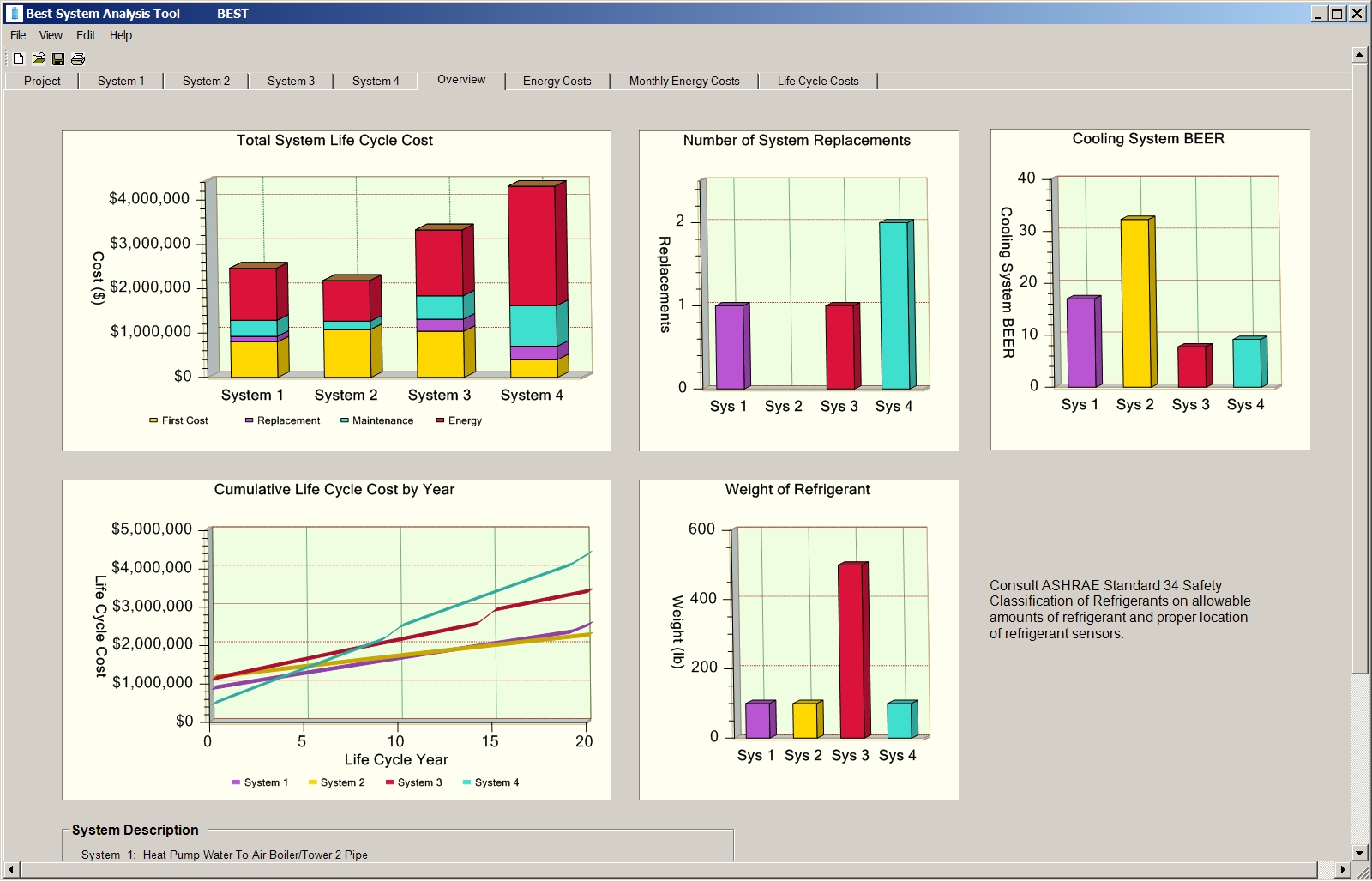For many years, HVAC industry professionals have lamented the inadequacy of efficiency ratings to evaluate different system types equitably, especially in the commercial realm.
Suffice it to say, the cornucopia of dissimilar efficiency rating systems (EER, IEER, SEER, AFUE, COP, etc.) for different commercial HVAC equipment makes the task of comparing real-world, as-applied system efficiencies and lifecycle costs a lengthy, arduous task. That is, until recently.
Members of the Hydronics Industry Alliance – Commercial (HIA-C), a committee of the Radiant Professionals Alliance, have recognized the importance of creating a common denominator among all HVAC system types. This would allow building owners, mechanical engineers, and design/build contractors to accurately compare real-world performance in a specific building. Ideally, this could be done in the early design phase, even before ground is broken. This idea emerged about five years ago, and the software has now come to fruition.
Available for free, the Building Efficiency System Tool (BEST) is a commercial building total HVAC system comparison tool that now solves the challenge of accurately comparing different styles of HVAC systems.
With the very simplest of inputs, BEST compares the energy performance, first cost, life cycle cost and more for all major types of HVAC systems and is broadly applicable to most commercial buildings, anywhere on the continent. All BEST outputs are represented in operating dollar figures, making comparison easy.
BEST does this quickly and accurately. It compares up to four system types in a matter of minutes, instead of hours or days. The software was not created to replace programs like EnergyPlus required by some rating agencies. BEST efficiently narrows the choices often run in EnergyPlus, significantly reducing design time.
“While different types of HVAC equipment are subject to various rating systems, the bigger issue is that they are all tested to different standards,” said Greg Cunniff, manager of application engineering at Taco Comfort Solutions.
“The testing parameters, lab procedures and resulting efficiency scores for some types of equipment are relatively comparable to their real-world performance,” added Cunniff. “For other systems, the discrepancy between tested and as-applied performance is surprisingly large. Owners, engineers and contractors needed a tool that refines the choices and compares all technologies on common ground.”
Free BEER
In addition to creating a powerful tool for professionals, the HIA-C is hoping that BEST offers a seat at the table for all its members.
The HIA-C is a diverse organization comprised of commercial manufacturers from the United States, Mexico and Canada. Through collaboration, even amongst staunch competitors, the most comprehensive comparison solution emerged.
“With BEST, professionals can rapidly analyze all the real-world HVAC options to determine the system that best meets budgetary and performance requirements,” said Rick Bostian, HIA-C chairman and business development manager at WaterFurnace International.
“In its most basic comparison function, the user only inputs the location for weather and utility data, building size, and number of stories to get a comparison of four options among the 30 predetermined systems,” he continued. “If desired, the design team can change any of the program’s defaults to more closely match the building. Without BEST, comparing a lot of ‘what if’ scenarios can be expensive and time consuming.”

Above: The BEST software allows users to compare different HVAC system types for a given building even before the design process begins.
BEST uses the Building Energy Efficiency Ratio™ (BEER), which combines certified AHRI data, including certified unit efficiency ratios, manufacturers’ published performance data, component performance curves, and the pipe or duct required in typical systems with “as applied” correction factors. BEST bridges the gap between laboratory test data and real world HVAC system performance, including installation and utility costs against calculated load and actual local weather.
“BEER rerates published efficiency data for actual operating conditions and any distribution energy that’s missing from AHRI data,” said Mark Handzel, VP product regulatory affairsat Xylem. “For example, pumping energy in a hydronic system is absent from AHRI numbers. And when VRF systems are AHRI tested in a lab, the demands on the compressor – based on length of refrigerant lines and load applied – are far less than what a typical field installation is likely to include.”
This type of rerate is applied in BEST per ASHRAE guidelines and certified manufacturers published data to all systems by identifying, per system, where energy is used to deliver comfort. These rerates are standard defaults in BEST, where most other programs require users to make their own adjustments.”
While a building’s heating, cooling and ventilation energy consumption and operating cost is of great importance, the intent of BEST is not to predict annual energy consumption of a given system.
Rather, BEST seeks to provide the user with a comprehensive comparison of multiple, complete HVAC systems using an identical load profile, specific to building size, weather patterns, installation and operating cost. BEST reports, in detail, the information needed for informed decisions regarding HVAC system selection at the early project design phase.
BEST outputs cumulative lifecycle cost by year, system payback time, pump and fan HP, total system integrated energy efficiency ratio (IEER) for cooling, coefficient of performance (COP) for heating, and more. The cost data is based on industry averages for first cost and maintenance costs collected from over 50 contractors around the U.S.
Quick adoption
The new software program has been five years in the making. BEST already has roughly 2,000 registrants. This number continues to grow as more professionals learn of its capabilities.
Now available at no cost, this game-changing, first-of-its-kind software provides the information owners and designers need to properly evaluate the many options available to heat and cool their buildings.
BEST avails real cost data, energy efficiency comparisons and lifecycle costs of the HVAC system long before detailed plans are created.
Learn more and download BEST for free at www.besthvac.org

